Decoupling Analysis of Water Consumption and Economic Growth in Tourism in Arid Areas: Case of Xinjiang, China
Abstract
1. Introduction
2. Literature Review
2.1. Tourism Water Consumption and Economic Development
2.2. Research Review
3. Study Regional Profiles and Methods
3.1. Study Regional Profiles
3.2. TWF-LCA Method and Decoupling Theory
3.3. Estimating Tourist’s WF
3.3.1. Date
3.3.2. Catering WF (C-WF)
3.3.3. Accommodation-Related WF (A-WF)
3.3.4. Traffic-Related WF (Tr-WF)
3.3.5. Visiting WF (V-WF)
3.3.6. Shopping WF (S-WF)
4. Results
4.1. The Tourism WF under Different Tourist Elements
4.2. Decoupling Analysis of Tourism Water Consumption and Tourism Economic Growth
5. Discussion and Conclusions
5.1. Limitations and Future Research Directions
5.2. Innovation
5.3. Managerial Implications and Advice
Author Contributions
Funding
Institutional Review Board Statement
Informed Consent Statement
Data Availability Statement
Conflicts of Interest
References
- Liu, J.; Feng, T.; Yang, X. The energy requirements and carbon dioxide emissions of tourism industry of Western China: A case of Chengdu city. Renew. Sustain. Energy Rev. 2011, 15, 2887–2894. [Google Scholar] [CrossRef]
- Wang, X.; Zhang, H. Establishment and application of regional tourism development potential evaluation system: A case study of western China. J. Arid. Land Resour. Environ. 2013, 27, 203–208. [Google Scholar]
- Yang, J.; Wang, J.; Wang, Z. Study on the influencing factors of rural residents’ tourism consumption intention: Based on the micro-data of six western provinces. J. Arid. Land Resour. Environ. 2017, 31, 196–202. [Google Scholar]
- Zheng, B.; Ming, Q.; Liu, A.; Zhang, X. A study on the coupling and interactive response between the efficiency of tourism economy and regional economic level in western provinces and regions. World Reg. Stud. 2022, 31, 350–362. [Google Scholar]
- National Bureau of Statistics. China Statistical Yearbook; National Bureau of Statistics: Beijing, China, 2018.
- Hadjikakou, M. Measuring the Impact of Tourism on Water Resources: Alternative frameworks. Ph.D. Thesis, University of Surrey, Guildford, UK, 2014. Available online: http://epubs.surrey.ac.uk/805395/ (accessed on 19 March 2014).
- Rico, A.; Olcina, J.; Baños, C.; Garcia, X.; Sauri, D. Declining water consumption in the hotel industry of mass tourism resorts: Contrasting evidence for Benidorm, Spain. Curr. Issues Tour. 2019, 23, 770–783. [Google Scholar] [CrossRef]
- Toth, E.; Bragalli, C.; Neri, M. Assessing the significance of tourism and climate on residential water demand: Panel-data analysis and non-linear modelling of monthly water consumptions. Environ. Model. Softw. 2018, 103, 52–61. [Google Scholar] [CrossRef]
- Baños, C.J.; Hernández, M.; Rico, A.M.; Olcina, J. The Hydrosocial Cycle in Coastal Tourist Destinations in Alicante, Spain: Increasing Resilience to Drought. Sustainability 2019, 11, 4494. [Google Scholar] [CrossRef]
- Li, J. Scenario analysis of tourism’s water footprint for China’s Beijing–Tianjin–Hebei region in 2020: Implications for water policy. J. Sustain. Tour. 2017, 26, 127–145. [Google Scholar] [CrossRef]
- Liu, H.; Jiang, Y.; Zhu, H.; Chen, Y.; Lyu, W.; Luo, W.; Zheng, Q.W. Analysis of water resource management in tourism in China using a coupling degree model. Water Policy 2021, 23, 765–782. [Google Scholar] [CrossRef]
- Wang, S.-X.; He, H.; Li, S.; Du, J.-K. Research progress of tourism footprint family in China. J. Nat. Resour. 2019, 34, 424–436. [Google Scholar] [CrossRef]
- Yang, M.; Hens, L.; De Wulf, R.; Ou, X. Measuring tourist’s water footprint in a mountain destination of Northwest Yunnan, China. J. Mt. Sci. 2011, 8, 682–693. [Google Scholar] [CrossRef]
- Huang, D. Tourism Water Footprint Evaluation and Empirical Study. Master’s Thesis, Hainan University, Haikou, China, 2015. [Google Scholar]
- Liu, X. Study on Water Footprint of Tourism Industry—Taking Wuhan as an Example. Master’s Thesis, Central China Normal University, Wuhan, China, 2016. [Google Scholar]
- Gössling, S. The consequences of tourism for sustainable water use on a tropical island: Zanzibar, Tanzania. J. Environ. Manag. 2001, 61, 179–191. [Google Scholar] [CrossRef]
- Gössling, S. New performance indicators for water management in tourism. Tour. Manag. 2015, 46, 233–244. [Google Scholar] [CrossRef]
- Liu, Z.; Wang, A.; Weber, K.; Chan Edwin, H.W.; Shi, W. Categorisation of cultural tourism attractions by tourist preference using location-based social network data: The case of Central, Hong Kong. Tour. Manag. 2022, 90, 104488. [Google Scholar] [CrossRef]
- Duan, X.; Luan, F. Evaluation of water resources carrying capacity in Xinjiang based on fuzzy comprehensive evaluation. China Popul. Resour. Environ. 2014, 24, 119–122. [Google Scholar]
- Zhou, H.; Zhai, C.; Sun, Z.; Chen, J. Analysis of comprehensive utilization effect and development change of water resources in Xinjiang. J. Arid. Land Resour. Environ. 2016, 30, 95–100. [Google Scholar]
- Dong, Y.; Jin, G.; Deng, X.; Wu, F. Multidimensional measurement of poverty and its spatiotemporal dynamics in China from the perspective of development geography. J. Geogr. Sci. 2021, 31, 130–148. [Google Scholar] [CrossRef]
- Hoekstra, A.Y.; Hung, P.Q. Globalisation of water resources: International virtual water flows in relation to crop trade. Glob. Environ. Chang. 2005, 15, 45–56. [Google Scholar] [CrossRef]
- Wu, M.; Mintz, M.; Wang, M.; Arora, S. Water Consumption in the Production of Ethanol and Petroleum Gasoline. Environ. Manag. 2009, 44, 981–997. [Google Scholar] [CrossRef]
- Chapagain, A.K.; Hoekstra, A.Y. Water Footprints of Nations; Value of Water Research Report Series No. 16; UNESCO-IHE Institute for Water Education: Delft, The Netherlands, 2004. [Google Scholar]
- Holder, J.S. Pattern and impact of tourism on the environment of the Caribbean. Tour. Manag. 1988, 9, 119–127. [Google Scholar] [CrossRef]
- Zhao, M.; Xi, J. Study on tourists’ pollution discharge behavior and water environment disturbance model in tourist areas—A case study of Liupanshan Eco-tourism area. Resour. Sci. 2012, 34, 2418–2426. [Google Scholar]
- Shang, T.; Sun, Y.; Li, X.; Xiao, L. Carrying capacity of ecotourism system based on system dynamics. J. Tianjin Univ. (Soc. Sci.) 2009, 11, 277–280. [Google Scholar]
- Wang, Q.; Zhang, J.; Yang, X. Analysis on water ecological carrying capacity of Huangshan Scenic Spot. Geogr. Res. 2009, 28, 1105–1114. [Google Scholar]
- Jie, Q.; Fu, G.; Liu, M.; Wang, Y.; Xu, J. Research on tourism water resources carrying capacity engineering in Hainan Province. Syst. Eng. Procedia 2011, 1, 384–391. [Google Scholar] [CrossRef]
- Gössling, S.; Peeters, P.; Hall, C.M.; Ceron, J.-P.; Dubois, G.; Lehmann, L.V.; Scott, D. Tourism and water use: Supply, demand, and security. An international review. Tour. Manag. 2012, 33, 1–15. [Google Scholar] [CrossRef]
- Hadjikakou, M.; Chenoweth, J.; Miller, G. Estimating the direct and indirect water use of tourism in the eastern Mediterranean. J. Environ. Manag. 2012, 114, 548–556. [Google Scholar] [CrossRef]
- Hadjikakou, M.; Miller, G.; Chenoweth, J.; Druckman, A.; Zoumides, C. A comprehensive framework for comparing water use intensity across different tourist types. J. Sustain. Tour. 2015, 23, 1445–1467. [Google Scholar] [CrossRef]
- Cazcarro, I.; Hoekstra, A.Y.; Sánchez Chóliz, J. The water footprint of tourism in Spain. Tour. Manag. 2013, 40, 90–101. [Google Scholar] [CrossRef]
- Cazcarro, I.; Duarte, R.; Sánchez Chóliz, J. Tracking Water Footprints at the Micro and Meso Scale: An Application to Spanish Tourism by Regions and Municipalities. J. Ind. Ecol. 2016, 20, 446–461. [Google Scholar] [CrossRef]
- Wang, Q.; Wu, C.; Deng, H.; Yang, X. Water footprint measurement model and empirical analysis of tourist destinations. Sci. Geogr. Sin. 2016, 35, 448–455. [Google Scholar]
- Sun, Y.Y.; Hsu, C.-M. The Decomposition Analysis of Tourism Water Footprint in Taiwan: Revealing Decision-Relevant Information. J. Travel Res. 2018, 58, 695–708. [Google Scholar] [CrossRef]
- He, Z.; Wang, R. Evaluation model and application of water supply and demand adaptability in tourism industry in arid areas: A case study of Xinjiang, China. J. Nat. Resour. 2021, 36, 3215–3231. [Google Scholar]
- Liu, S.; Gao, J. Study on the influence of tourism activities on the water environment of coastal baths. Environ. Monit. China 2013, 29, 1–4. [Google Scholar]
- Huang, C.; Jia, T. The influence of tourism activities on water environment of urban forest park—A case study of Gongqing Forest Park in Shanghai. J. Northwest For. Coll. 2010, 25, 192–197. [Google Scholar]
- Chang, Y.; Liu, H. Research on water carrying capacity of water resources in arid region of Northwest China based on water footprint theory. J. Shihezi Univ. (Nat. Sci. Ed.) 2015, 1, 116–121. [Google Scholar]
- Liang, R. Research on the Carrying Limit of Water Ecology in Idle Tourism Farms: A Case Study of Sichuan Province. China’s Agric. Resour. Zoning 2016, 37, 186–190. [Google Scholar]
- Wang, J.; Zhou, H. Carrying capacity of tourism water resources in the northern foothills of the Qinling Mountains in Xi’an. J. Northwestern Univ. (Nat. Sci. Ed.) 2015, 45, 996–1000. [Google Scholar]
- Huang, Z.; Yuan, L. Research on Environmental Carrying Capacity Evaluation of Seaside Tourism Sites: A Case Study of Jiangsu Seaside Wetland Ecotourism Sites. Geogr. Sci. 2008, 4, 578–584. [Google Scholar]
- Skrimizea, E.; Parra, C. Social-ecological dynamics and water stress in tourist islands: The case of Rhodes, Greece. J. Sustain. Tour. 2019, 27, 1438–1456. [Google Scholar] [CrossRef]
- Sun, C.; Liu, L.; Fan, F. Spatial and temporal pattern analysis of China’s industrial water consumption growth quality based on CD-ESDA model. Econ. Geogr. 2020, 30, 1529–1535. [Google Scholar]
- Liu, Y.; Du, J.; Zhang, J. Kuznets hypothesis and verification of agricultural water use and economic growth in China. Resour. Environ. Yangtze Basin 2008, 17, 593–597. [Google Scholar]
- Zhang, T.; Cheng, S.; Tao, S.; Gao, C.; Zhang, J. Spatio-temporal characteristics of ecological footprint and decoupling effect in Nanjing. Resour. Environ. Yangtze Basin 2017, 26, 350–358. [Google Scholar]
- Zhang, R.; Xi, J.; Ge, Q. Tourist Carbon Footprint Analysis Based on Life Cycle Theory: A Measurement Framework and Empirical Research of “Low-carbon Tourism”. Arid. Land Resour. Environ. 2015, 29, 169–175. [Google Scholar]
- Koçak, E.; Şarkgüneşi, A. The renewable energy and economic growth nexus in Black Sea and Balkan countries. Energy Policy 2016, 100, 51–57. [Google Scholar] [CrossRef]
- Farhani, S.; Solarin, S.A. Financial development and energy demand in the United States: New evidence from combined cointegration and asymmetric causality tests. Energy 2017, 134, 1029–1037. [Google Scholar] [CrossRef]
- Qi, Y.; Zhang, Y. Study on the dynamic relationship between the evolution of Beijing’s three industries and PM2.5 emissions. China Population. Resour. Environ. 2015, 25, 15–23. [Google Scholar]
- Carter, A.P. The economics of technological change. Sci. Am. 1996, 214, 25–31. [Google Scholar] [CrossRef]
- Gai, M.; Cao, G.; Tian, C.; Ke, L. Analysis on the decoupling of energy consumption carbon emission and regional economic growth in Liaoning Coastal Economic Zone. Resour. Sci. 2014, 36, 1267–1277. [Google Scholar]
- Lu, N.; Yi, L.; Feng, P. Analysis on the decoupling between water resource utilization and economic development in the capital cities of the five provinces in northwest China. J. Arid. Land Resour. Environ. 2022, 36, 107–112. [Google Scholar]
- Xia, Y.; Zhong, M. The relationship between decoupling theory of economic development and environmental pollution and EKC hypothesis. China Popul. Resour. Environ. 2016, 26, 8–16. [Google Scholar]
- Pan, A.; Chen, L. An analysis of the decoupling between the utilization of water resources and the coordinated development of economy in Hubei Province—Based on the perspective of water footprint. Resour. Sci. 2014, 36, 328–333. [Google Scholar]
- Li, R.; Bai, Y.; Zhou, Y.; Huang, S.; Yan, Z.; Li, Y.; Zhao, H. Decoupling of water resources utilization and economic growth in the Yellow River Basin and decomposition of influencing factors. Sci. Geogr. Sin. 2021, 43, 110–118. [Google Scholar]
- Yi, P.; Fang, S.; Ma, C. Evaluation on the decoupling of tourism economic growth and ecological environment pressure in Geopark—A case study of Songshan World Geopark. J. Nat. Resour. 2014, 29, 1282–1296. [Google Scholar]
- Zhang, Y.; Pan, B.; Li, J.; Gu, A. Study on the relationship between industrial water use and economic growth in China based on Kuznets Curve. Resour. Sci. 2017, 39, 1117–1126. [Google Scholar]
- Tapio, P. Towards a theory of decoupling: Degrees of decoupling in the EU and the case of road traffic in Finland between 1970 and 2001. Transp. Policy 2005, 12, 137–151. [Google Scholar] [CrossRef]
- GB50015-2003; Code for design of building water supply and drainage. National Standard of the People’s Republic of China: Beijing, China, 2003.
- GB 3838-2002; Environmental quality standards for surface water. National Standard of the People’s Republic of China: Beijing, China, 2002.
- The Chinese Dietary Guideinees. Available online: http://dg.en.cnsoc.org/ (accessed on 15 February 2017).
- Okadera, T.; Chontanawat, J.; Gheewala, S.H. Water footprint for energy production and supply in Thailand. Energy 2014, 77, 49–56. [Google Scholar] [CrossRef]
- Liu, J.; Wu, L.; Li, Y.; Lin, C.; Zhu, H. Study on direct and virtual water consumption of rural tourism in Qingcheng Houshan Heritage Site. Tour. Trib. 2018, 33, 108–116. [Google Scholar]
- Fu, G.J. Assessment of ecological footprint of foreign tourists in Hainan Province. Resour. Sci. 2006, 5, 145–151. [Google Scholar]
- Kriti, K.; Haresh, K.; Shalini, C.; Samarjit, K. Forecasting foreign tourist arrivals in India using a single time series approach based on rough set theory. Int. J. Comput. Sci. Math. 2022, 16, 340–354. [Google Scholar]
- Sharma, H.; Kumar Kumari, K.; Kar, S. Air passengers forecasting for Australian airline based on hybrid rough set approach. J. Appl. Math. Stat. Inform. 2018, 14, 5–18. [Google Scholar] [CrossRef]
- Ayres, A. Germany’s water footprint of transport fuels. Appl. Energy 2014, 113, 1746–1751. [Google Scholar] [CrossRef]
- Becken, S.; Simmons, D.G. Understanding energy consumption patterns of tourist attractions and activities in New Zealand. Tour. Manag. 2002, 23, 343–354. [Google Scholar] [CrossRef]
- Pan, Z.; Xu, C. Analysis on decoupling of water resources utilization and economic growth in China. J. South China Agric. Univ. (Soc. Sci. Ed.) 2019, 18, 97–108. [Google Scholar]
- Wang, A.; Zhang, A.; Chan, E.H.W.; Shi, W.; Zhou, X.; Liu, Z. A Review of Human Mobility Research Based on Big Data and Its Implication for Smart City Development. ISPRS Int. J. Geo-Inf. 2020, 10, 13. [Google Scholar] [CrossRef]
- Shi, W.; Batty, M.; Goodchild, M.; Li, Q. The digital transformation of cities. Urban Inform. 2022, 1, 1. [Google Scholar] [CrossRef]
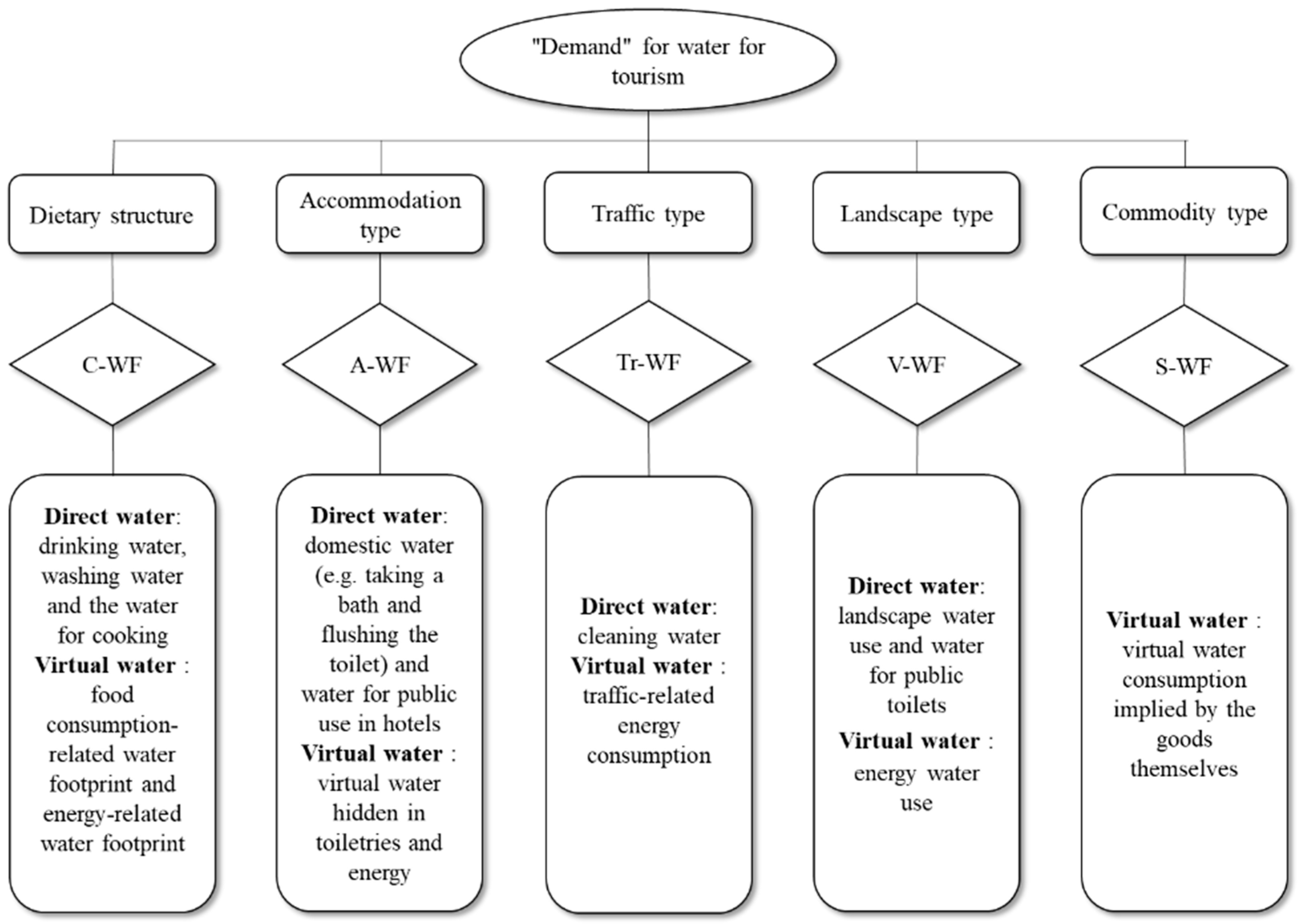
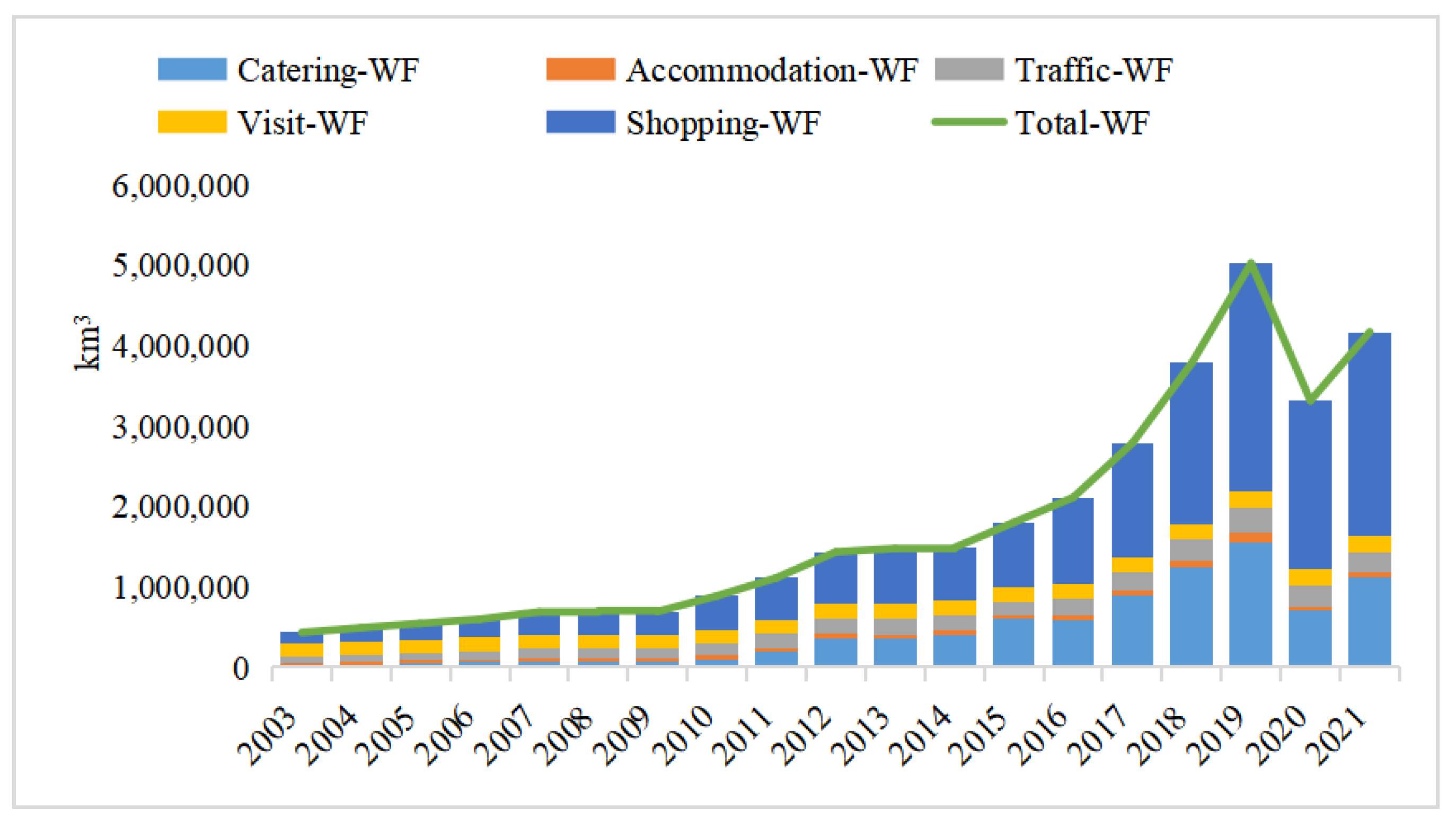

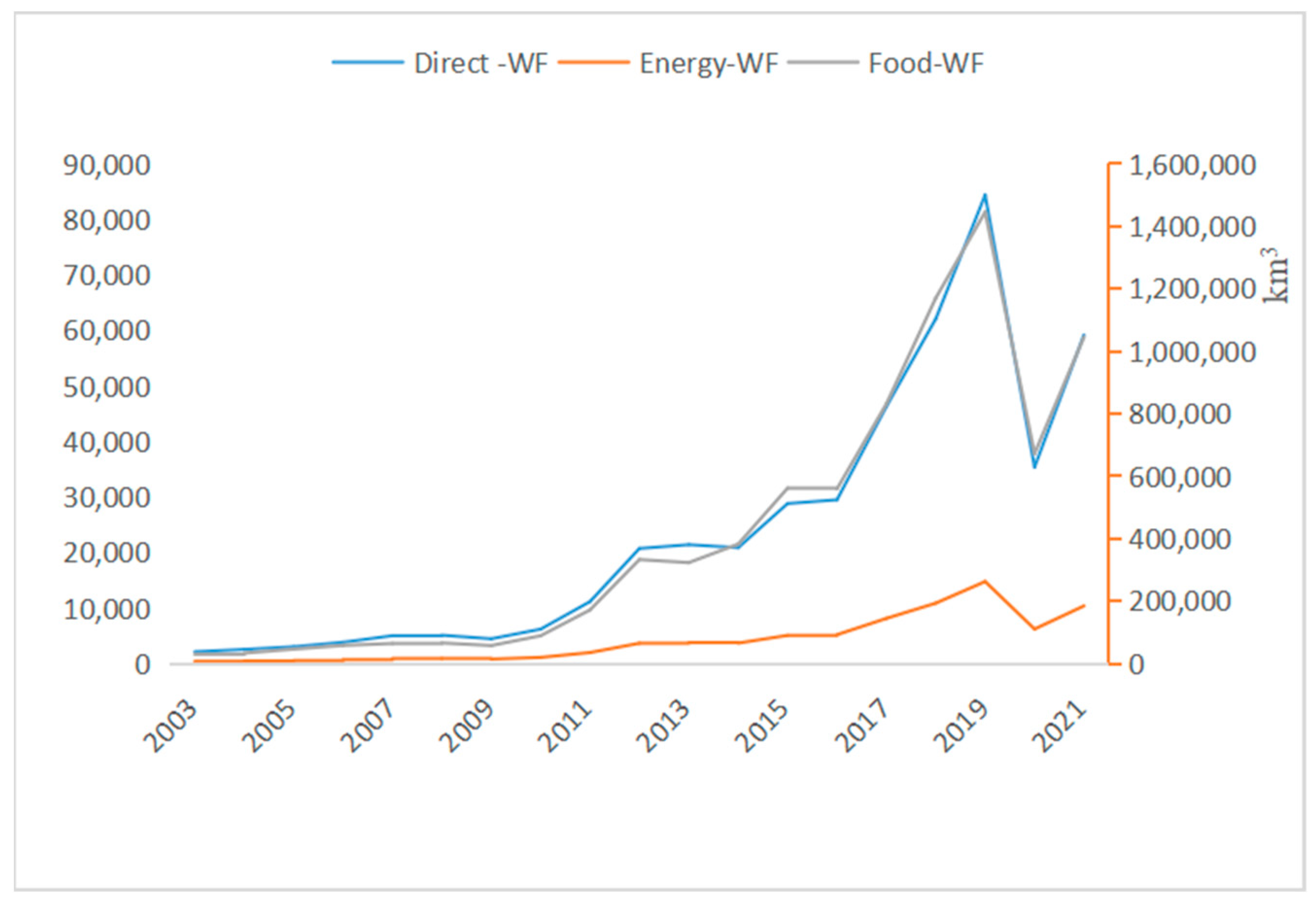
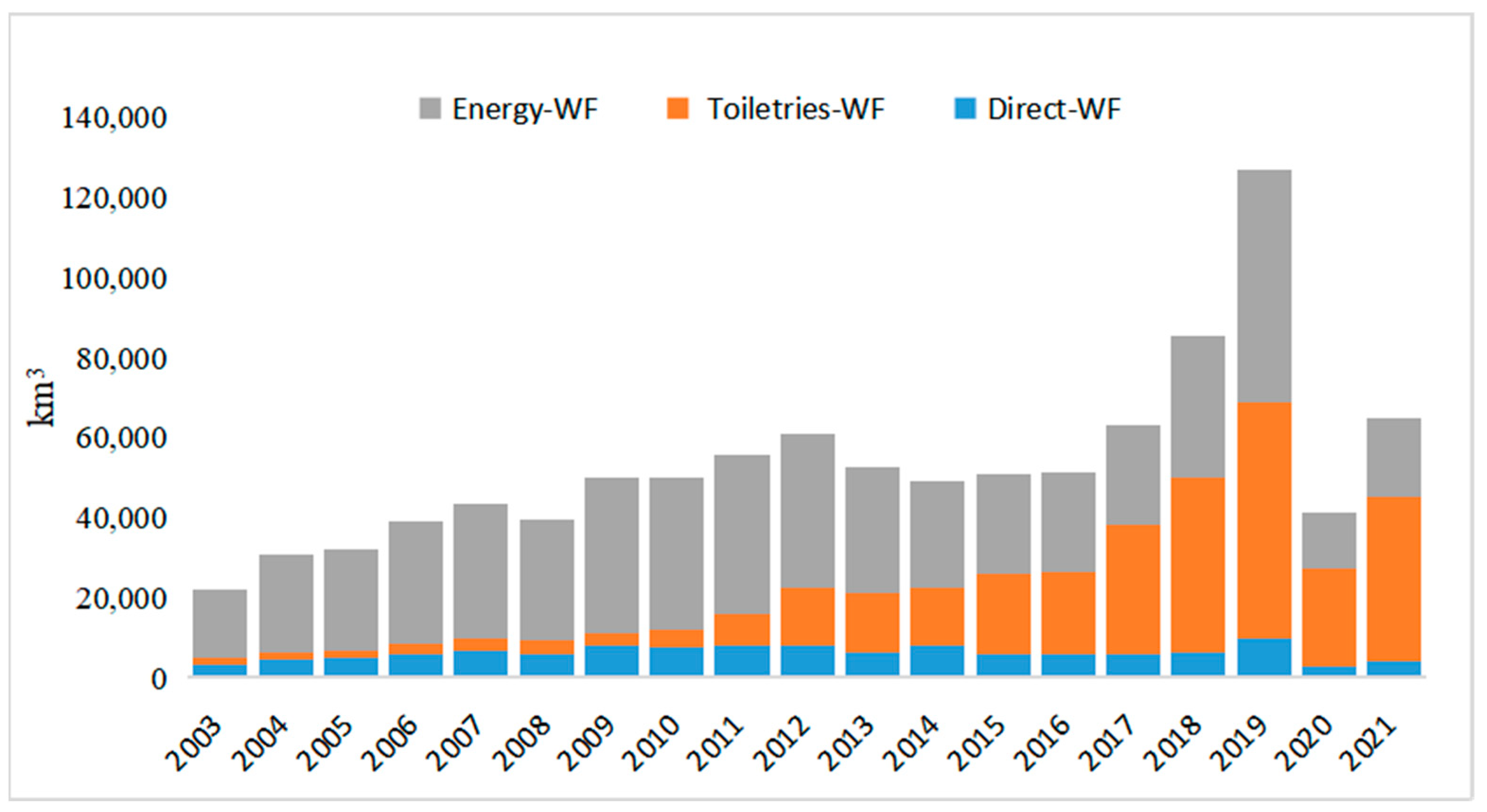
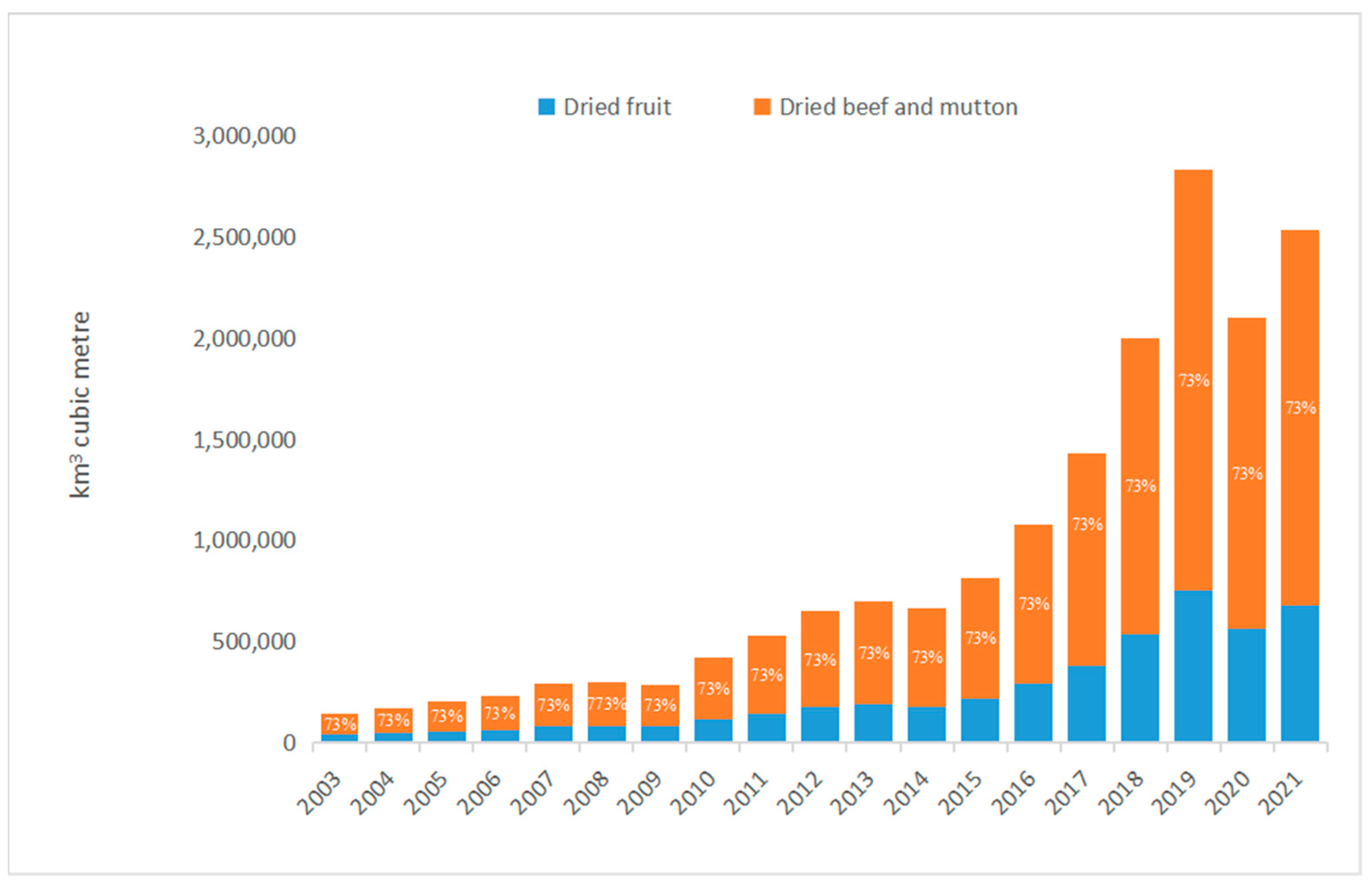
| Decoupling Type | Et | Implication | ||
|---|---|---|---|---|
| Strong decoupling | <0 | >0 | <0 | Tourism water footprint decline and Tourism economic growth |
| Weak decoupling | >0 | >0 | 0–0.8 | Tourism water footprint growth rate < Tourism economic growth rate |
| >0 | >0 | 0.8–1 | ||
| Recessive decoupling | <0 | <0 | 1–1.2 | Tourism water footprint decline rate > Tourism economic recession rate |
| <0 | <0 | 1.2–2 | ||
| Critical state | >0 | >0 | =1 | Change rate of tourism water footprint = Change rate of tourism economy |
| <0 | <0 | =1 | ||
| Expansive negative decoupling | >0 | >0 | 1–1.2 | Tourism water footprint growth rate > Tourism economic growth rate |
| >0 | >0 | 1.2–2 | ||
| Weak negative decoupling | <0 | <0 | 0–0.8 | Tourism water footprint decline rate < Tourism economic recession rate |
| <0 | <0 | 0.8–1 | ||
| Strong negative decoupling | >0 | <0 | <0 | Tourism water footprint growth and Tourism economic decline |
| Categories of Catering Consumption | Unit Virtual Water Content |
|---|---|
| cereal | 1.972 (m3/kg) |
| oil | 3.26 (m3/kg) |
| vegetables | 0.15 (m3/kg) |
| beef and mutton | 8.881 (m3/kg) |
| poultry | 3.652 (m3/kg) |
| aquatic product | 5.00 (m3/kg) |
| dairy | 1.00 (m3/kg) |
| fruit | 0.82 (m3/kg) |
| natural gas | 0.11 (m3/GJ) |
| Accommodation Type | Average Water Consumption L/Bed·Day (Tourist) | Average Water Consumption L/Bed·Day (Hotel Staff) |
|---|---|---|
| Five-star luxury hotel | 450 | 80 |
| Four-star high-grade hotel | 400 | |
| Three-star comfortable hotel | 375 | |
| Economy hotel | 200 | |
| Hostel | 150 |
| Type | Unit Consumption | Unit Virtual Water Content |
|---|---|---|
| toiletries | CNY 5/person·day | - |
| electric energy | 3 kwh/bed·day | 0.43 m3/GJ |
| natural gas | 1.96 cubic meter/bed·day | 0.11 m3/GJ |
| Tourist’s Origin | Average Travel Distance to Xinjiang (km) * | |
|---|---|---|
| Domestic tourists (provincial capitals) | East China (Shanghai, Nanjing, Hangzhou, Hefei, Fuzhou, Nanchang, Jinan) | 3457.43 |
| North China (Beijing, Tianjin, Taiyuan, Shijiazhuang, Hohhot) | 2602.20 | |
| Central China (Wuhan, Changsha, Zhengzhou) | 3023.00 | |
| South China (Haikou, Nanning, Guangzhou) | 3898.33 | |
| Northeast China (Harbin, Changchun, Shenyang)) | 3532.33 | |
| Southwest China (Chengdu, Guiyang, Kunming, Lhasa, Chongqing) | 2789.00 | |
| Northwest China (Xi’an, Lanzhou, Xining, Yinchuan) | 1826.75 | |
| Foreign Tourists (capital city) | Japan, South Korea, Malaysia, Philippines, Singapore, Thailand, U.S.A, Canada, Britain, France, Germany, Russia, and Australia | 6331.60 |
| Energy Types | Unit Virtual Water Content (m3/GJ) |
|---|---|
| Aviation kerosene | 1.06 |
| Gasoline and diesel | 0.575 |
| Electric energy | 0.43 |
| Transport Modes | Unit energy Consumption (GJ/Person·km) |
|---|---|
| Air | 0.002 |
| Railway | 0.001 |
| Private car | 0.0018 |
| Coach | 0.0007 |
| Tourist’s Origin | International Visitors | Domestic Visitors | ||
|---|---|---|---|---|
| E–WF of Different Means of Transportation (km3) | ||||
| Year | Air (International) | Air (Domestic) | Railway | Private Car |
| 2003 | 2289.1 | 3766.7 | 760.7 | 4467.9 |
| 2004 | 4253.5 | 4622.8 | 933.6 | 5483.4 |
| 2005 | 4444.6 | 5452.8 | 1101.2 | 6467.9 |
| 2006 | 4865.5 | 6182.3 | 1248.6 | 7333.2 |
| 2007 | 5884.7 | 7913.0 | 1598.1 | 9386.2 |
| 2008 | 4874.3 | 8169.9 | 1650.0 | 9690.8 |
| 2009 | 4763.4 | 7808.8 | 1577.1 | 9262.6 |
| 2010 | 14,298.0 | 11,307.5 | 2283.7 | 13,412.6 |
| 2011 | 17,784.1 | 14,251.7 | 2878.2 | 16,904.9 |
| 2012 | 20,106.6 | 17,534.5 | 3541.2 | 20,798.9 |
| 2013 | 21,036.2 | 18,792.5 | 3795.3 | 22,291.1 |
| 2014 | 20,155.8 | 17,876.9 | 3610.4 | 21,205.0 |
| 2015 | 22,596.7 | 22,067.9 | 4456.8 | 26,176.3 |
| 2016 | 26,911.4 | 29,407.8 | 5939.1 | 34,882.6 |
| 2017 | 31,517.2 | 39,047.8 | 7886.0 | 46,317.3 |
| 2018 | 35,246.3 | 54,944.6 | 11,096.5 | 65,173.6 |
| 2019 | 22,804.0 | 78,613.0 | 15,876.6 | 93,248.3 |
| 2020 | 817.1 | 161,299.4 | 11,880.6 | 19,750.5 |
| 2021 | 0.0 | 70,930.8 | 14,325.1 | 84,135.8 |
| Year | Energy Consumption of Different Means of Transportation (km3) | |||
|---|---|---|---|---|
| Air | Railway | Private Car | Coach | |
| 2003 | 1665.7 | 1992.8 | 3344.8 | 57,214.5 |
| 2004 | 2180.5 | 2310.3 | 4104.9 | 62,745.4 |
| 2005 | 2642.8 | 2548.5 | 4842.0 | 69,831.4 |
| 2006 | 2768.1 | 2856.2 | 5489.8 | 71,990.4 |
| 2007 | 2808.4 | 4250.6 | 7026.6 | 78,801.3 |
| 2008 | 2922.3 | 2875.8 | 7254.7 | 88,315.2 |
| 2009 | 3323.1 | 3035.2 | 6934.1 | 91,226.9 |
| 2010 | 2476.3 | 3272.1 | 10,040.9 | 95,921.7 |
| 2011 | 2117.2 | 4324.4 | 12,655.2 | 102,822.8 |
| 2012 | 2864.5 | 4589.0 | 15,570.3 | 111,742.3 |
| 2013 | 3061.0 | 4920.4 | 16,687.4 | 119,218.8 |
| 2014 | 3562.5 | 5044.9 | 15,874.3 | 112,333.4 |
| 2015 | 2991.4 | 5848.4 | 19,595.9 | 63,939.5 |
| 2016 | 25,388.6 | 6632.5 | 26,113.5 | 53,229.1 |
| 2017 | 25,892.0 | 7089.2 | 34,673.7 | 36,732.8 |
| 2018 | 26,907.5 | 7183.0 | 48,789.7 | 15,832.6 |
| 2019 | 28,258.8 | 7981.5 | 69,806.8 | 1823.3 |
| 2020 | 11,600.2 | 2581.3 | 52,236.9 | 4063.2 |
| 2021 | 19,851.3 | 3311.4 | 62,985.1 | 2293.5 |
| Transport Modes | Unit Virtual Water Consumption (L/Person·km) |
|---|---|
| Air | 2.120 |
| Railway | 0.430 |
| Private car | 1.026 |
| Coach | 0.399 |
| Year | Direct Water (km3) | Virtual Water (km3) | |
|---|---|---|---|
| Water for Public Toilets | Water for Greening | Energy Consumption | |
| 2003 | 1800.8 | 164,824.8 | 110.6 |
| 2004 | 2229.0 | 164,824.8 | 136.9 |
| 2005 | 2621.7 | 164,824.8 | 161.0 |
| 2006 | 2970.2 | 164,824.8 | 182.5 |
| 2007 | 3797.2 | 164,824.8 | 233.3 |
| 2008 | 3904.8 | 164,824.8 | 239.9 |
| 2009 | 3733.6 | 164,824.8 | 229.4 |
| 2010 | 5502.9 | 164,824.8 | 338.0 |
| 2011 | 6932.6 | 164,824.8 | 425.9 |
| 2012 | 8506.4 | 164,824.8 | 522.5 |
| 2013 | 9110.0 | 164,824.8 | 559.6 |
| 2014 | 8668.0 | 164,824.8 | 532.5 |
| 2015 | 10,670.4 | 164,824.8 | 655.5 |
| 2016 | 14,177.6 | 164,824.8 | 870.9 |
| 2017 | 18,770.2 | 164,824.8 | 1153.0 |
| 2018 | 26,293.6 | 164,824.8 | 1615.2 |
| 2019 | 37,258.7 | 164,824.8 | 2288.7 |
| 2020 | 27,670.0 | 164,824.8 | 1699.7 |
| 2021 | 33,349.8 | 164,824.8 | 2048.6 |
| Period | Et | Decoupling Type | ||
|---|---|---|---|---|
| 2003–2004 | >0 | >0 | 0.52 | Weak decoupling |
| 2004–2005 | >0 | >0 | 0.59 | Weak decoupling |
| 2005–2006 | >0 | >0 | 0.64 | Weak decoupling |
| 2006–2007 | >0 | >0 | 0.53 | Weak decoupling |
| 2007–2008 | >0 | >0 | 1.99 | Expansive negative decoupling |
| 2008–2009 | <0 | <0 | 0.13 | Weak negative decoupling |
| 2009–2010 | >0 | >0 | 0.43 | Weak decoupling |
| 2010–2011 | >0 | >0 | 0.57 | Weak decoupling |
| 2011–2012 | >0 | >0 | 0.94 | Weak decoupling |
| 2012–2013 | >0 | >0 | 0.18 | Weak decoupling |
| 2013–2014 | >0 | <0 | −0.21 | Strong negative decoupling |
| 2014–2015 | >0 | >0 | 0.37 | Weak decoupling |
| 2015–2016 | >0 | >0 | 0.47 | Weak decoupling |
| 2016–2017 | >0 | >0 | 1.06 | Expansive negative decoupling |
| 2017–2018 | >0 | >0 | 0.86 | Weak decoupling |
| 2018–2019 | >0 | >0 | 0.53 | Weak decoupling |
| 2019–2020 | <0 | <0 | 0.45 | Weak negative decoupling |
| 2020–2021 | >0 | >0 | 0.60 | Weak decoupling |
Disclaimer/Publisher’s Note: The statements, opinions and data contained in all publications are solely those of the individual author(s) and contributor(s) and not of MDPI and/or the editor(s). MDPI and/or the editor(s) disclaim responsibility for any injury to people or property resulting from any ideas, methods, instructions or products referred to in the content. |
© 2023 by the authors. Licensee MDPI, Basel, Switzerland. This article is an open access article distributed under the terms and conditions of the Creative Commons Attribution (CC BY) license (https://creativecommons.org/licenses/by/4.0/).
Share and Cite
Cao, S.; He, Z.; Wang, S.; Niu, J. Decoupling Analysis of Water Consumption and Economic Growth in Tourism in Arid Areas: Case of Xinjiang, China. Sustainability 2023, 15, 10379. https://doi.org/10.3390/su151310379
Cao S, He Z, Wang S, Niu J. Decoupling Analysis of Water Consumption and Economic Growth in Tourism in Arid Areas: Case of Xinjiang, China. Sustainability. 2023; 15(13):10379. https://doi.org/10.3390/su151310379
Chicago/Turabian StyleCao, Shanshan, Zhaoli He, Songmao Wang, and Jinlan Niu. 2023. "Decoupling Analysis of Water Consumption and Economic Growth in Tourism in Arid Areas: Case of Xinjiang, China" Sustainability 15, no. 13: 10379. https://doi.org/10.3390/su151310379
APA StyleCao, S., He, Z., Wang, S., & Niu, J. (2023). Decoupling Analysis of Water Consumption and Economic Growth in Tourism in Arid Areas: Case of Xinjiang, China. Sustainability, 15(13), 10379. https://doi.org/10.3390/su151310379






